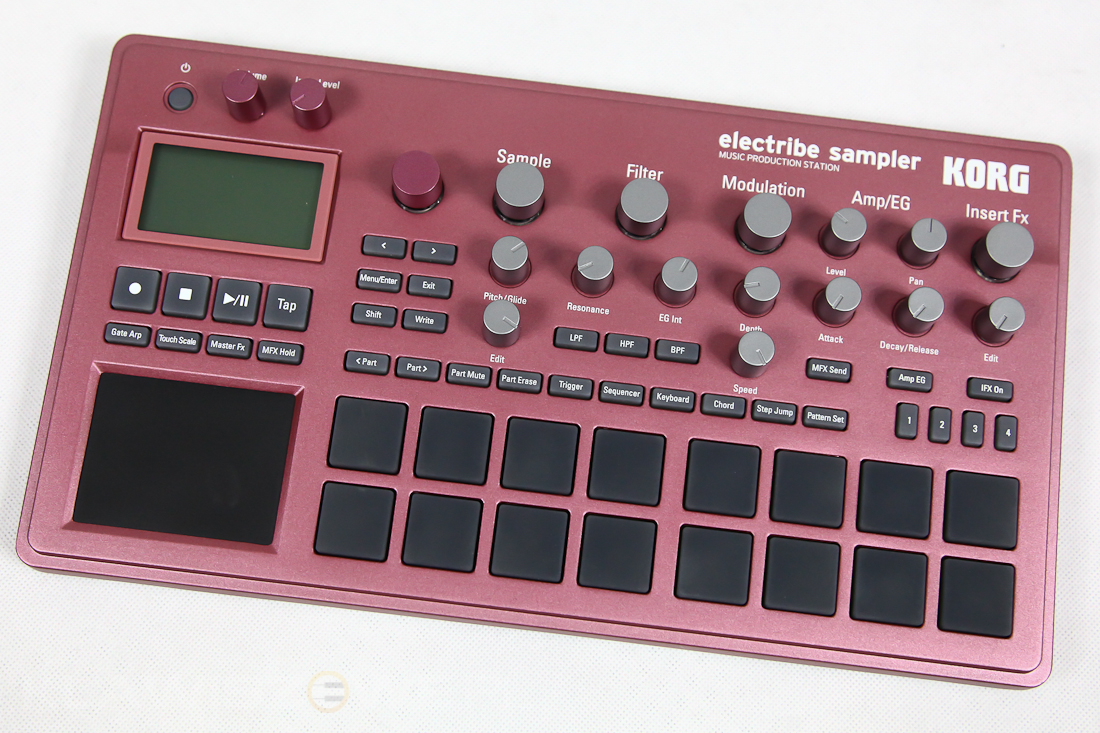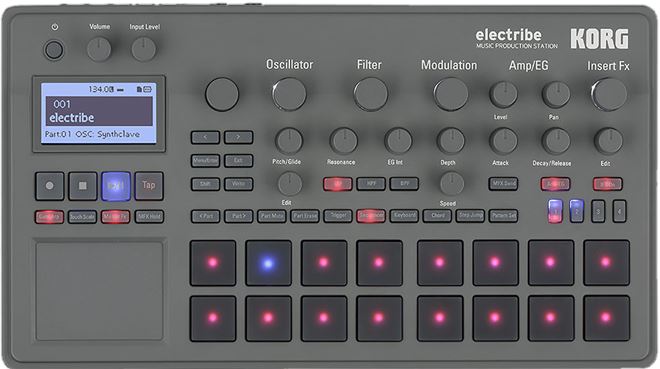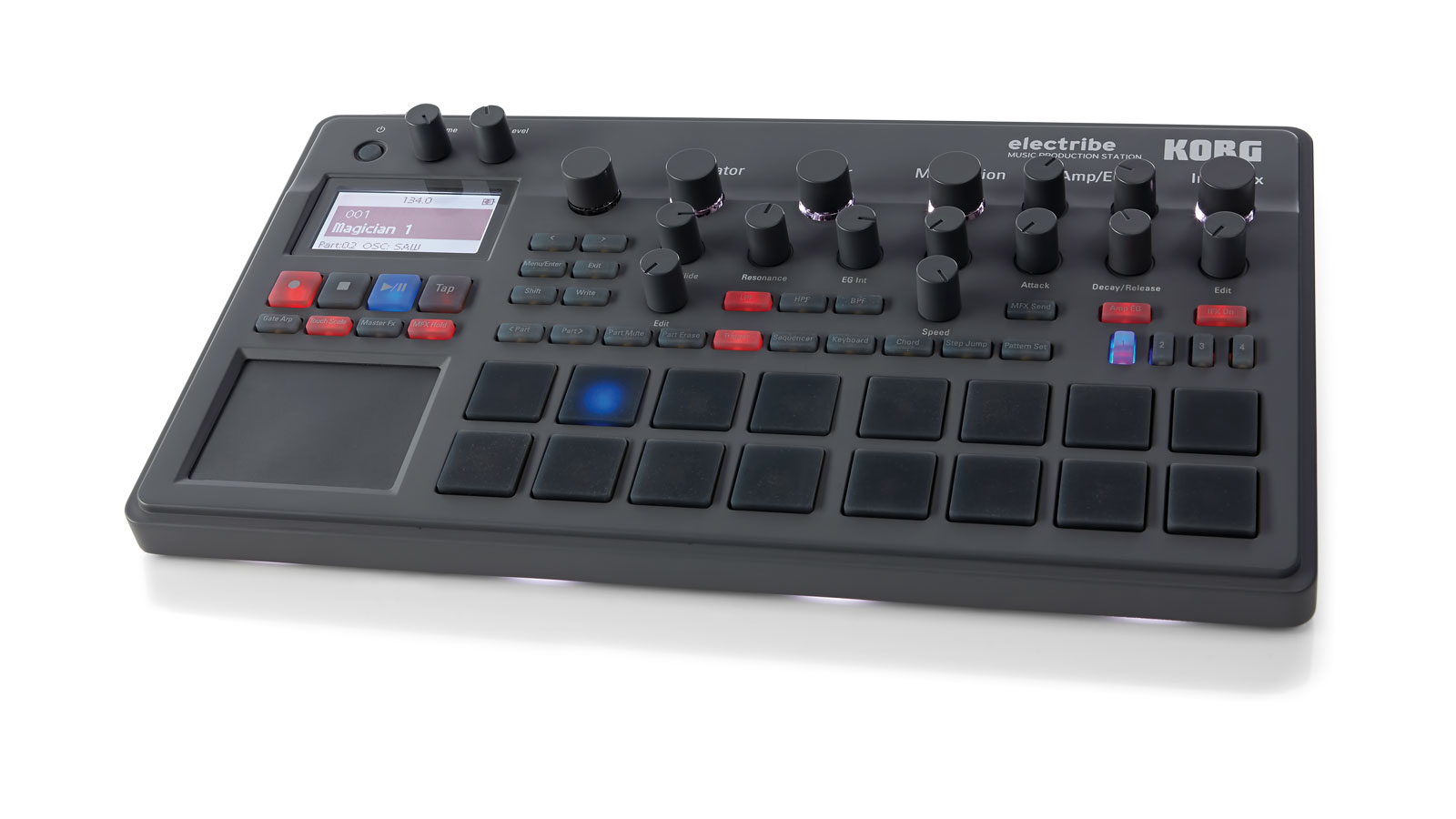Like all workstations of power, the Electribe 2 offers many ways in which one might perform, compose and simply jam out. While there are many possible workflows, I thought I might share some of my own small procedures that have really been saving me time and adding more creativity to my sessions with my Electribe 2.
- Set the pattern parameter ALTERNATE 13-14 and ALTERNATE 15-16 to the On setting. Don't use the following Insert FX which have a high processing load. 06 Ring Modulator, 18 Delay 1/4, 19 Delay 3/16, 20 Delay 1/8, 21 Delay 1/16, 22 Roller 1/32, 23 One Delay, 24 Short Delay, 25 Ring Delay1, 26 Ring Delay2, 27 Chorus, 28 Flanger LFO, 29 Flanger.
- . Pattern Set Play lets you register sixty-four patterns in the sixteen step keys, and switch patterns as you perform. Tap tempo and MIDI Clock can be used to synchronize the ER-1 mk II 's performance with an exter.
Electribe 2 Pattern Settings
A 9V power adapter is supplied too but for making music on the move, the Electribe 2 can run on six AA batteries, promising five hours from a full set of nickel–metal hydrides. A micro–USB B socket on the side is your route to direct PC or Mac MIDI connectivity, although you’ll need to source the cable yourself.
The electribe/electribe sampler is a production station for dance music that is capable of creating original music. Using the knobs and the touch pad on the main unit enables you to edit sounds to easily create rhythm and phrase patterns with a single unit. Basic operation for the electribe sampler is the same as for the electribe. The Circuit Tracks is one of several like-minded grooveboxes such as the MC-101 and Electribe 2, which all come in at a sub-$500 price point and share a similar featureset. The Circuit Tracks has its strengths and weaknesses when compared to these devices, as well as when compared objectively to other music making methods such as DAWs.
1. Clear Sequence Not Pattern
As you get to know the Electribe 2, you quickly discover that it does not save patches, like a regular synth, or sampler. And that the Patterns, especially the artist or manufacturer produced patches, have some of the best, and most produced sounds, or ‘parts’. If you want to create some original sequences of your own with the manufacturer produced parts, then try this:
Hold down the Shift button and press the 6th button over from the left, on the bottom row. This brings the Clear Sequence function up, where you can remove the musical sequence for the Part in which you are currently working. But, the Part settings, like FX, Modulation, Motion Recordings and more are left.
If you use the Part buttons, you can keep the Clear Sequence Function up, and just press Part Left (Or, Part Right), multiple times, till all parts are cleared. Suddenly, you’ve got a palette of 16 sounds to work with, within a pattern, and no sequences assigned. Go to town!
2. Save For Success
The last tip offers a way to free up manufacturer (or anyone else’s) patterns from sequences, so you can use the Parts, within the Electribe 2 Patterns for your own music. And, while it’s really cool, you may not want to have to go back through and clear things up, every time you want to start a new song, or just a jam session. I actually kind of like clearing up several patterns of sequences that I know I’ll use the Parts of. For example: I may choose a pattern within my Electribe 2 out of manufacturer pattern 019 Tricky Slippy 2, simply for the Part sounds. I like the drums, bass, orchestra hit, and so on. There’s nothing I would change.
Electribe 2 Pattern Set Up Instructions
I can save this pattern without the sequences to either the same pattern number ‘019’. Or, I can save it with a new name and simply call it Tricky Kit, by holding down the Shift button, and then pressing Write. By changing the name, I let ‘future me’ know that this pattern is only sounds, and that I can start ‘tricking’ on it, as soon as I pull it up. If I store several patterns like this, I am never stuck in a moment of having to come up with things on the fly. Or I never leave myself in a situation where I’m frantically clearing parts before I perform. I just pull up one of my kits, and start free-styling, performing, or simply having fun.

Electribe 2 Pattern Set Up Tool
3. Choose Wisely
The Electribe 2s both give you multiple ways of choosing Parts, through either the Part buttons, through triggering different parts in trigger mode, and so on. One really easy way to do this, without having to trigger anything, is to hold down either the Trigger, Sequencer, Keyboard, or Chord buttons, and then press the Pad assigned to the part you’d like to assume control over. This allows you to silently jump on to different parts during sets, performances and recordings without clueing in your audience that you are part switching. And, once the shortcut becomes second nature, I feel, that this shortcut goes a long way in making you feel like you have a little more control.
4. Make New From Old

If you’re rocking the Electribe 2 Synth, and do not have a way to bring in new samples of your own, and you’re running out of drums, you might want to enable the Amp EG (Amplitude Envelope Generator) and trim down the decay, or attack. By adjusting either parameter on an existing raw sample (or oscillator) within the Oscillator section, you can easily create new sounds. Especially if you adjust the pitch, in addition to trimming from the head and tail of the sound.
And these aren’t the only options. Korg, themselves, threw in an additional, and much appreciated feature, with the Edit knob, over in the Oscillator section. Slowly turning the Edit knob will also reveal additional tweaks, effects and dynamic shifts. So, don’t even think for a second that you’re limited with the sound. In fact, Korg has supplied you with enough audio building blocks to keep you tweaking for a long time.
5. Scale It

A common strategy for building songs is through making multiple patterns. Heck, that’s really the entire gist of the Electribe. And, while this is cool, with pattern sequencing, it can get a little old having to re-sequence a bass, arp, or other accompanying pattern, every time you want to add a new section to a song. With Scale Mode, you can speed this process up immensely. Try this out:
Start off sequencing a basic pattern consisting of bass, drums, and maybe a lead that pops in here and there.
Then, for the bass and lead parts that you created, set both of these parts to Scale Mode: On.

Now, when I change the Key of the Pattern, within the Program Menu, you’ll notice that the bass and the lead change keys, accordingly along with the Pattern Key. Sadly, their key change is instantaneous. So, it can be a little tricky changing the key to your pattern in real time. Hopefully, Korg will make this feature cue and play along with the Pattern Changes, in the future. This would mean you could guide your song simply by turning a knob. Maybe they’ll make it where you can Key Scale using a MIDI controller?!
Conclusion
The Electribe 2s are powerful, amazing, and great sounding machines. And, like all machines, they have quirks, as well as serious pros. I’m hoping that with some of these tips, music making with your Electribe 2 will seem a little more straight forward.

Related Videos
The electribe and electribe sampler have essentially the same functions, but their sound engines are significantly different.
electribe: Synthesizer
- Contains an analog modeling sound engine with 55 different sounds (the electribe sampler has only 16)
- Contains 16 different types of filter (the electribe sampler has only three)
electribe sampler: Sampler
- You can use any sounds by sampling (the electribe uses only preset samples)
- Supports stereo samples and sample slicing (the electribe does not)
However, both models contain a simple modeling sound engine and standard drum samples, so it's easy to make beats using either model. Choose the model that's best for the sounds that you use most.
- Notes are sometimes missing during playback
When the electribe or electribe sampler reach the limit of their processing capability, a currently-playing note is sometimes turned off. In such situations, you can increase the maximum polyphony by lightening the load of each part. Some ways to lighten the load are listed below.
- Set the part parameter VOICE ASSIGN to Mono1/Mono2 for parts that play single notes.
- Set the pattern parameter ALTERNATE 13-14 and ALTERNATE 15-16 to the On setting.
- Don't use the following Insert FX which have a high processing load.
06 Ring Modulator, 18 Delay 1/4, 19 Delay 3/16, 20 Delay 1/8, 21 Delay 1/16, 22 Roller 1/32, 23 One Delay, 24 Short Delay, 25 Ring Delay1, 26 Ring Delay2, 27 Chorus, 28 Flanger LFO, 29 Flanger +, 30 Flanger -
- On parts that do not use Insert FX, set the IFX Type to 01 Punch.
- On parts that do not use Filter, set Filter Type to the Off setting.
In addition, for parts where the disappearing note is noticeable, you can set the part parameter PART PRIORITY to High. This will not increase the maximum polyphony, but notes of that part will be less likely to be turned off.
- How do I check the current system version?
On the electribe or electribe sampler, the system software must be on the SD card in order to view the version. Download the latest version of the software, and save it on an SD card.
- With the SD card inserted in the electribe or electribe sampler, turn on the power.
- Access the data utility SOFTWARE UPDATE, and press the [Menu/Enter] button once.
- The screen indicates 'Now Version' and the current version.
- Note the version, and press the [Exit] button.